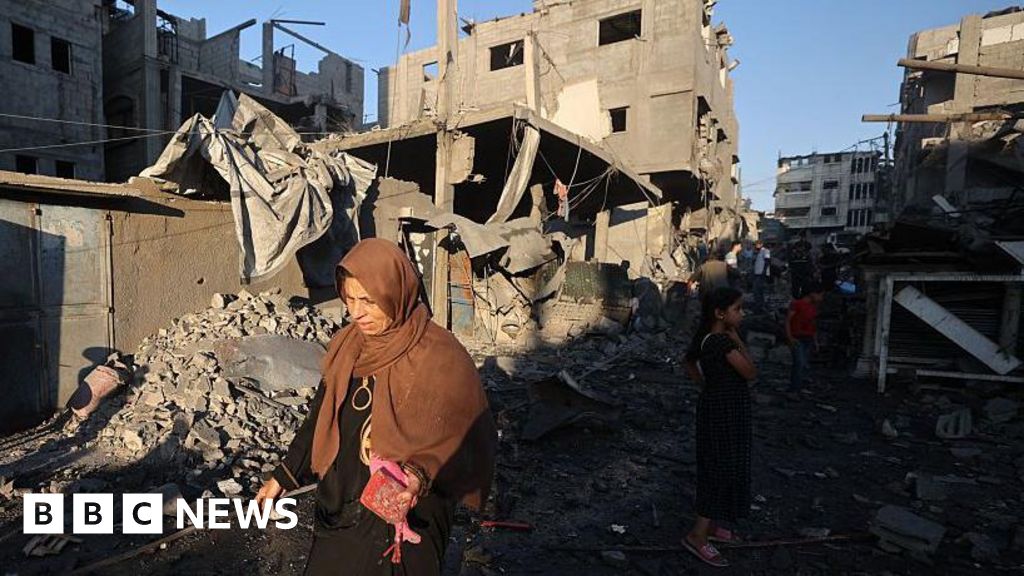Australia's Recognition of Palestine: Potential Repercussions and Implications

Introduction
Australia's decision to recognise Palestine as a state at the UN General Assembly in September has sparked controversy and potential repercussions from the US. The move, announced by centre-left Prime Minister Anthony Albanese, comes as the situation in Gaza has reached a critical point.
The Situation in Gaza
The Gaza Strip, home to nearly 2 million Palestinians, has been under an Israeli blockade since 2007. The UN has warned of a humanitarian crisis in the area, with limited access to basic necessities such as food, water, and electricity. The recent conflict between Israel and Hamas, the ruling party in Gaza, has only exacerbated this dire situation.
The Risk of US Anger
The US has been a close ally of Israel, and any move to recognise a Palestinian state could potentially strain relations between the two countries. However, Australia's recognition of Palestine is in line with its support for a two-state solution and its commitment to international law and human rights.
Implications for the Region
Australia's recognition of Palestine could have far-reaching implications for the region. It may encourage other nations to follow suit and put pressure on Israel to find a peaceful resolution to the conflict. It also sends a strong message to the international community about the importance of upholding human rights and supporting the Palestinian people.
Conclusion
About the People Mentioned
Anthony Albanese
Anthony Albanese, born on March 2, 1963, in Sydney, Australia, is an Australian politician serving as the 31st Prime Minister of Australia since May 23, 2022. He is a member of the Australian Labor Party and has represented the Sydney seat of Grayndler in Parliament since 1996. Albanese grew up in public housing raised by a single mother on a disability pension, a background that shaped his commitment to social equity and government support for disadvantaged Australians[2][5][8].
Albanese held several significant roles before becoming Prime Minister, including Minister for Infrastructure, Transport, Regional Development, and Local Government (2007–2010), during which he oversaw major nation-building projects such as roads, railways, and the National Broadband Network rollout, contributing to economic growth and improved connectivity across Australia[2][3]. He briefly served as Deputy Prime Minister in 2013. After the Labor Party’s electoral defeat in 2013, he continued in opposition and was elected leader of the Labor Party and Leader of the Opposition in May 2019, running unopposed[1][3].
As Prime Minister, Albanese’s government has pursued progressive policies including environmental protections, aiming for a 43% reduction in emissions by 2030, increased minimum wage, expanded support for workers, subsidized childcare, aged care reforms, and paid leave for domestic violence victims. His administration also donated $100 million in aid to Ukraine during the Russia-Ukraine conflict and restored diplomatic relations with China after a long freeze, marked by a key meeting with Chinese President Xi Jinping[1][4]. Albanese advocates for Indigenous recognition through a constitutional referendum to establish a Voice to Parliament, a move toward reconciliation with Aboriginal and Torres Strait Islander peoples[4].
Albanese is noted for his progressive stance on social issues, including support for abortion rights, drug decriminalization, same-sex marriage, transgender rights, and refugee acceptance. He has also emphasized strengthening Australia’s economic and military ties with Europe and the United States[1][4].
About the Organizations Mentioned
UN
The **United Nations (UN)** is a global intergovernmental organization founded in 1945 with the primary mission of maintaining international peace and security, promoting human rights, and fostering sustainable development. The UN was established in the aftermath of World War II, succeeding the League of Nations, with the aim of preventing future wars and promoting global cooperation.
### History and Structure
The UN is headquartered in New York City, with additional offices in Geneva, Nairobi, Vienna, and The Hague. It comprises six principal organs: the **General Assembly**, **Security Council**, **Economic and Social Council**, **International Court of Justice**, **Secretariat**, and **Trusteeship Council**. The organization includes 193 member states and two observer states, making it the most representative global body.
### Key Functions and Achievements
- **Peacekeeping and Security**: The UN plays a crucial role in maintaining international peace and security through peacekeeping missions and conflict resolution efforts.
- **Human Rights and Development**: It promotes human rights, supports refugees, and works towards sustainable development through specialized agencies like **UNICEF** and **WHO**.
- **Economic and Social Development**: The UN has been instrumental in economic and social development, particularly during the decolonization era. It has also been recognized for its leadership in peace and human development, with several agencies awarded the **Nobel Peace Prize**.
### Current Status and Challenges
Despite its achievements, the UN faces ongoing challenges, including debates over its effectiveness, financial contributions, and perceived biases. Recent global events, such as the COVID-19 pandemic, have highlighted the complexities and criticisms surrounding the UN's role.
### Notable Aspects
- **Global Influence**: The UN serves as a platform for dialogue among nations, addressing global challenges and promoting international cooperation.
- **Specialized Agencies**: It has 15 specialized agencies that perform diverse functions, from facilitating international travel to addressing pandemics.
- **International Law**: The UN plays a significant role in
US
The query seems to be about providing a summary of the organization "US," which could be interpreted as the United States government or a specific entity within it. However, without a clear reference to an "organization" named "US," I will provide a comprehensive overview of the United States government, focusing on its structure, history, achievements, current status, and notable aspects relevant to business and technology.
## Overview of the United States Government
The United States government is a federal republic with a system divided into three branches: the legislative, executive, and judicial. This structure is designed to provide checks and balances on each branch.
## History
The U.S. government was established in 1789 under the Constitution, which outlines the framework of the federal system. Over time, the government has evolved through numerous amendments and reforms, shaping policies and laws that impact various sectors, including business and technology.
## Key Achievements
- **Economic Growth**: The U.S. has been a global leader in economic growth, innovation, and technological advancements, fostering a strong business environment.
- **Technological Advancements**: The government has supported significant technological developments, such as the internet and space exploration, through funding and regulatory frameworks.
- **Regulatory Frameworks**: Agencies like the Federal Trade Commission (FTC) and the Federal Communications Commission (FCC) play crucial roles in regulating industries and ensuring consumer protection.
## Current Status
Currently, the U.S. government is engaged in various initiatives to address contemporary challenges such as climate change, cybersecurity, and healthcare reform. The government also continues to evolve its organizational structure, with ongoing discussions about the role of the executive branch, as seen in initiatives like Project 2025.
## Notable Aspects
- **Project 2025**: This initiative, backed by the Heritage Foundation, aims to restructure the federal government to align with conservative ideals, potentially impacting civil rights and executive branch powers.
- **Standards and Regulations**: The U.S. Standards Strategy,
Hamas
**Hamas** is a Sunni Islamist Palestinian nationalist organization that functions both as a political party and a militant group, primarily operating in the Gaza Strip, which it has governed since 2007. Founded in 1987 by Ahmed Yassin amid the First Intifada, Hamas emerged from the Muslim Brotherhood and initially had covert Israeli support as a counterweight to the secular Palestinian Liberation Organization (PLO)[3][1]. It combines political governance with an armed wing, the al-Qassam Brigades, committed to armed resistance against Israel, which it refuses to recognize as a legitimate state[1][3].
Hamas’s political rise culminated in a 2006 electoral victory in the Palestinian Legislative Council, campaigning on anti-corruption and resistance platforms. After violently seizing Gaza from the rival Fatah faction in 2007, Hamas has maintained de facto control there despite international isolation and blockades imposed by Israel and Egypt[3]. Its governance has been marked by repeated conflicts with Israel, including major wars in 2008–09, 2012, 2014, 2021, and the ongoing intense conflict triggered by Hamas’s surprise October 2023 attack killing nearly 1,200 Israelis and taking hostages[1][2][3].
Hamas benefits from regional support, especially from Iran, which supplies funding and weapons, as well as financial and political backing from Turkey and Qatar. These alliances form part of a broader "axis of resistance" against Israel, which includes groups like Hezbollah and Palestinian Islamic Jihad[2]. Hamas also operates fundraising networks globally, sometimes using charities as fronts to support its military activities[4].
The group is designated a terrorist organization by many countries, including the United States, which has increased military aid to Israel following recent escalations[2][6]. Despite modifying its 1988 charter in 2017 to soften some language, Hamas continues to reject Israel’s legitimacy and pursues all forms of resistance[1]. Its enduring political
🔗 Connected Events Overview
Discover related stories and their connections to this article
10
Connected Events
7
People Involved
49
Total Tags
260
Total Views
📊 Quick Insights
Most Recent Event:
12 Aug 2025
Time Span:
1 month
Most Popular Tag:
us
Average Views:
26
📅 Connected Events Timeline
Explore connected events with detailed insights and relationships
1
2
3
4
5
6
7
8
9
10
👥 People Involved in Connected Events
Connected through:
🏢 Organizations & Products
Key entities mentioned across connected events
🏢 Organizations
United States
Israel
Western nations
Australia
Politico
European Union
Hamas
UN
US
UN Human Rights Council
Columbia University
ICE
Secretary of State
🛍️ Products
No products found in connected events
💡 Connected Events Insights
Discover patterns and trends across related stories
📈
260
Total Engagement
⏱️
1 month
Time Span
🎯
49
Total Topics
🔥 Trending Topics
#us
#un
#human_rights
#sanctions
#australia
#gaza
#palestine
#hamas
#ceasefire
#middle_east
Trending Blogs in Politics

Deadly Israeli Raid in Southern Syria Targets Beit Jinn
#middle_east
#politics
#conflict
#israel
#syria
Thirteen killed as Israeli forces strike Beit Jinn in southern Syria, drawing condemnation and regional escalation concerns.

Investigations Intensify Around Zelensky's Chief of Staff
#politics
#ukraine
#corruption
#investigations
#energoatom
NABU widens its probe into Andriy Yermak over alleged Energoatom embezzlement as he resigns amid political fallout.

Guinea-Bissau Coup: President Flees to Senegal as Regional Bodies Condemn Takeover
#guinea_bissau
#coup
#senegal
#regional_stability
#politics
Guinea-Bissau's president fled to Senegal after a military takeover as regional bodies condemn the coup and call for restoring constitutional order.

Caribbean Double-Tap Strike Sparks Legal Debate
#caribbean
#narcoterrorism
#maritime_interdiction
#law
The US conducts a second airstrike on a narcotics vessel in Caribbean waters, raising legal questions and triggering international scrutiny.

MAGA Voter Divide: GOP Faces Rift Between Loyalists and Moderate Trump Supporters
#maga
#trump
#republicans
#polls
A POLITICO poll finds a third of 2024 Trump voters aren’t MAGA, signaling a non-monolithic base.
About the People Mentioned
Anthony Albanese
Anthony Albanese, born on March 2, 1963, in Sydney, Australia, is an Australian politician serving as the 31st Prime Minister of Australia since May 23, 2022. He is a member of the Australian Labor Party and has represented the Sydney seat of Grayndler in Parliament since 1996. Albanese grew up in public housing raised by a single mother on a disability pension, a background that shaped his commitment to social equity and government support for disadvantaged Australians[2][5][8]. Albanese held several significant roles before becoming Prime Minister, including Minister for Infrastructure, Transport, Regional Development, and Local Government (2007–2010), during which he oversaw major nation-building projects such as roads, railways, and the National Broadband Network rollout, contributing to economic growth and improved connectivity across Australia[2][3]. He briefly served as Deputy Prime Minister in 2013. After the Labor Party’s electoral defeat in 2013, he continued in opposition and was elected leader of the Labor Party and Leader of the Opposition in May 2019, running unopposed[1][3]. As Prime Minister, Albanese’s government has pursued progressive policies including environmental protections, aiming for a 43% reduction in emissions by 2030, increased minimum wage, expanded support for workers, subsidized childcare, aged care reforms, and paid leave for domestic violence victims. His administration also donated $100 million in aid to Ukraine during the Russia-Ukraine conflict and restored diplomatic relations with China after a long freeze, marked by a key meeting with Chinese President Xi Jinping[1][4]. Albanese advocates for Indigenous recognition through a constitutional referendum to establish a Voice to Parliament, a move toward reconciliation with Aboriginal and Torres Strait Islander peoples[4]. Albanese is noted for his progressive stance on social issues, including support for abortion rights, drug decriminalization, same-sex marriage, transgender rights, and refugee acceptance. He has also emphasized strengthening Australia’s economic and military ties with Europe and the United States[1][4].
About the Organizations Mentioned
UN
The **United Nations (UN)** is a global intergovernmental organization founded in 1945 with the primary mission of maintaining international peace and security, promoting human rights, and fostering sustainable development. The UN was established in the aftermath of World War II, succeeding the League of Nations, with the aim of preventing future wars and promoting global cooperation. ### History and Structure The UN is headquartered in New York City, with additional offices in Geneva, Nairobi, Vienna, and The Hague. It comprises six principal organs: the **General Assembly**, **Security Council**, **Economic and Social Council**, **International Court of Justice**, **Secretariat**, and **Trusteeship Council**. The organization includes 193 member states and two observer states, making it the most representative global body. ### Key Functions and Achievements - **Peacekeeping and Security**: The UN plays a crucial role in maintaining international peace and security through peacekeeping missions and conflict resolution efforts. - **Human Rights and Development**: It promotes human rights, supports refugees, and works towards sustainable development through specialized agencies like **UNICEF** and **WHO**. - **Economic and Social Development**: The UN has been instrumental in economic and social development, particularly during the decolonization era. It has also been recognized for its leadership in peace and human development, with several agencies awarded the **Nobel Peace Prize**. ### Current Status and Challenges Despite its achievements, the UN faces ongoing challenges, including debates over its effectiveness, financial contributions, and perceived biases. Recent global events, such as the COVID-19 pandemic, have highlighted the complexities and criticisms surrounding the UN's role. ### Notable Aspects - **Global Influence**: The UN serves as a platform for dialogue among nations, addressing global challenges and promoting international cooperation. - **Specialized Agencies**: It has 15 specialized agencies that perform diverse functions, from facilitating international travel to addressing pandemics. - **International Law**: The UN plays a significant role in
US
The query seems to be about providing a summary of the organization "US," which could be interpreted as the United States government or a specific entity within it. However, without a clear reference to an "organization" named "US," I will provide a comprehensive overview of the United States government, focusing on its structure, history, achievements, current status, and notable aspects relevant to business and technology. ## Overview of the United States Government The United States government is a federal republic with a system divided into three branches: the legislative, executive, and judicial. This structure is designed to provide checks and balances on each branch. ## History The U.S. government was established in 1789 under the Constitution, which outlines the framework of the federal system. Over time, the government has evolved through numerous amendments and reforms, shaping policies and laws that impact various sectors, including business and technology. ## Key Achievements - **Economic Growth**: The U.S. has been a global leader in economic growth, innovation, and technological advancements, fostering a strong business environment. - **Technological Advancements**: The government has supported significant technological developments, such as the internet and space exploration, through funding and regulatory frameworks. - **Regulatory Frameworks**: Agencies like the Federal Trade Commission (FTC) and the Federal Communications Commission (FCC) play crucial roles in regulating industries and ensuring consumer protection. ## Current Status Currently, the U.S. government is engaged in various initiatives to address contemporary challenges such as climate change, cybersecurity, and healthcare reform. The government also continues to evolve its organizational structure, with ongoing discussions about the role of the executive branch, as seen in initiatives like Project 2025. ## Notable Aspects - **Project 2025**: This initiative, backed by the Heritage Foundation, aims to restructure the federal government to align with conservative ideals, potentially impacting civil rights and executive branch powers. - **Standards and Regulations**: The U.S. Standards Strategy,
Hamas
**Hamas** is a Sunni Islamist Palestinian nationalist organization that functions both as a political party and a militant group, primarily operating in the Gaza Strip, which it has governed since 2007. Founded in 1987 by Ahmed Yassin amid the First Intifada, Hamas emerged from the Muslim Brotherhood and initially had covert Israeli support as a counterweight to the secular Palestinian Liberation Organization (PLO)[3][1]. It combines political governance with an armed wing, the al-Qassam Brigades, committed to armed resistance against Israel, which it refuses to recognize as a legitimate state[1][3]. Hamas’s political rise culminated in a 2006 electoral victory in the Palestinian Legislative Council, campaigning on anti-corruption and resistance platforms. After violently seizing Gaza from the rival Fatah faction in 2007, Hamas has maintained de facto control there despite international isolation and blockades imposed by Israel and Egypt[3]. Its governance has been marked by repeated conflicts with Israel, including major wars in 2008–09, 2012, 2014, 2021, and the ongoing intense conflict triggered by Hamas’s surprise October 2023 attack killing nearly 1,200 Israelis and taking hostages[1][2][3]. Hamas benefits from regional support, especially from Iran, which supplies funding and weapons, as well as financial and political backing from Turkey and Qatar. These alliances form part of a broader "axis of resistance" against Israel, which includes groups like Hezbollah and Palestinian Islamic Jihad[2]. Hamas also operates fundraising networks globally, sometimes using charities as fronts to support its military activities[4]. The group is designated a terrorist organization by many countries, including the United States, which has increased military aid to Israel following recent escalations[2][6]. Despite modifying its 1988 charter in 2017 to soften some language, Hamas continues to reject Israel’s legitimacy and pursues all forms of resistance[1]. Its enduring political
🔗 Connected Events Overview
Discover related stories and their connections to this article
📊 Quick Insights
📅 Connected Events Timeline
Explore connected events with detailed insights and relationships
👥 People Involved in Connected Events
Connected through:
🏢 Organizations & Products
Key entities mentioned across connected events
🏢 Organizations
🛍️ Products
💡 Connected Events Insights
Discover patterns and trends across related stories
🔥 Trending Topics
Trending Blogs in Politics

Deadly Israeli Raid in Southern Syria Targets Beit Jinn
#middle_east #politics #conflict #israel #syria
Thirteen killed as Israeli forces strike Beit Jinn in southern Syria, drawing condemnation and regional escalation concerns.

Investigations Intensify Around Zelensky's Chief of Staff
#politics #ukraine #corruption #investigations #energoatom
NABU widens its probe into Andriy Yermak over alleged Energoatom embezzlement as he resigns amid political fallout.

Guinea-Bissau Coup: President Flees to Senegal as Regional Bodies Condemn Takeover
#guinea_bissau #coup #senegal #regional_stability #politics
Guinea-Bissau's president fled to Senegal after a military takeover as regional bodies condemn the coup and call for restoring constitutional order.

Caribbean Double-Tap Strike Sparks Legal Debate
#caribbean #narcoterrorism #maritime_interdiction #law
The US conducts a second airstrike on a narcotics vessel in Caribbean waters, raising legal questions and triggering international scrutiny.
MAGA Voter Divide: GOP Faces Rift Between Loyalists and Moderate Trump Supporters
#maga #trump #republicans #polls
A POLITICO poll finds a third of 2024 Trump voters aren’t MAGA, signaling a non-monolithic base.









